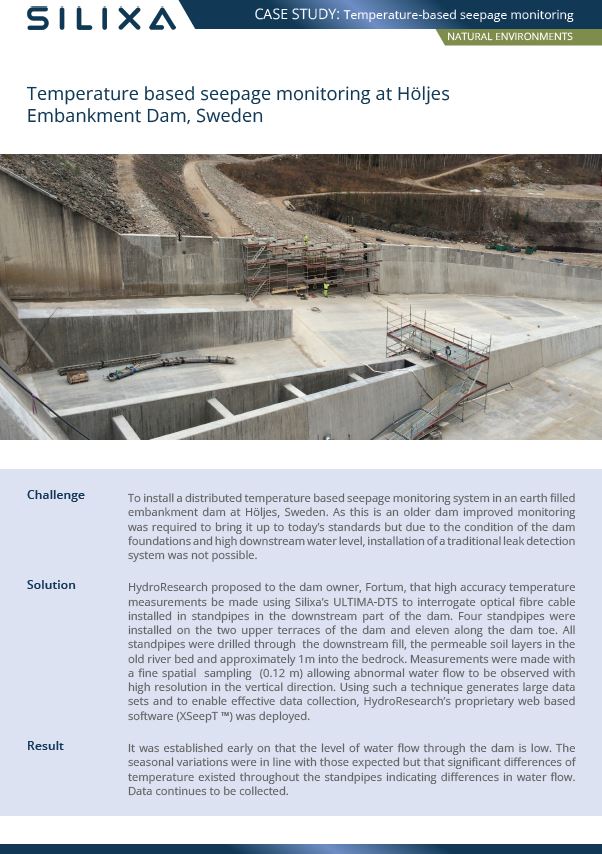Dam Monitoring Systems
XSeepT™, from HydroResearch, is a high-precision distributed fibre optic sensing-based seepage Dam Monitoring System that provides continuous understanding of dam conditions, taking dam safety to a higher level.
It is a cost-effective and reliable dam monitoring system that monitors the entire dam structure in real-time.
Watch our video to learn how XSeepT reduces the risk of dam failure.
XSeepT utilises the highest spatial resolution temperature data from Silixa’s ULTIMA DTS, distributed temperature sensor, to detect small seepage flow changes and to calculate seepage rates in a dam structure. Any change in the seepage flow rates can be an indication of erosion, one of the most common causes of dam failure.
The seepage flow causes a seasonal temperature variation inside the dam. With Silixa’s range of distributed fibre optic sensing technologies and fibre optic cables this seasonal temperature variation can be measured with excellent spatial resolution along an embankment or tailings dam.The measured data can then, via XSeepT (a real-time data evaluation system), be used for automatic evaluation of the seepage flow through the dam.
This temperature variation is therefore dependent on seepage flow, the seasonal variation at the inflow boundary, and the distance from the boundary to the measuring point. As the seepage flow increases the temperature in the dam will change, and the seasonal variation will increase as shown in the figure. Generally, a constant temperature indicates a minimal seepage of fluid, whilst large seasonal variations may indicate significant seepage.

Temperature variation at increasing seepage
Monitoring the entire dam in real-time with high accuracy
As the fibre is the sensor, measurements can be taken along the full length of the fibre optic cable enabling operators to gain detailed information along the entire dam. Distributed sensing makes it possible to detect very small, localised changes in the seepage flow rates that would otherwise go unnoticed. It delivers temperature readings with the precision of point sensors with the undisputable advantage of fibreoptics: the highest possible spatial coverage.
Cost-effective system
As the fibre is the sensor, the system offers an extended measurement array at a relatively low-cost. There is no maintenance or power requirement for the fibre. Also, depending on the optical fibre cable design and its positioning, strain and acoustic measurements can be acquired as part of the integrity health checks.
Remote monitoring
Cloud based data presentation enables remote dam monitoring. Measured and evaluated data is offered in different formats locally and/or at a cloud-based server. Different data diagrams are available enabling remote access and interpretation.
Early warnings of potential problems
The system processes the high-resolution temperature data in real-time, detecting even minimal temperature changes. In the case of a sudden temperature change an alarm can be sent via SMS or E‑mail.
Easy integration with existing SCADA or ADAS systems
Processed data can be automatically exported and integrated into existing SCADA or ADAS systems.
Small environmental footprint
The dam monitoring systems have a low-power requirement and no power is required to the sensing cable.
Low cost of ownership
No maintenance costs associated with the fibre optic cable.
Surveillance of monitoring performance and quality check of cable
The system provides automatic warning of a cable break and diagnostics allow the signal quality to be checked on demand.
Seepage detection based on optical fibre distributed temperature sensing has been established as a key technology and has significantly improved monitoring capabilities of dam operators.
The installation of sensing optical fibre networks offers additional advantages as the technology of optical fibre distributed sensing develops further. Additional measurement techniques based on the same optical fibre cable to map seepage below the drainage system and identify density changes in the subsurface geology.
Seepage occurs in embankment and earth dams as the impounded water seeks path of least resistance through the dam and its foundations. Excessive seepage becomes a concern and may be a threat to the integrity of the structure that could lead to the failure of the dam.
Mapping seepage paths, continuous and real time monitoring require a dense deployment of sensing networks, high tech surveillance systems to capture and understand subsurface processes and prevent erosion.
Downloads
Case study: Temperature based seepage monitoring at Holjes Embankment Dam, Sweden
Challenge: to install a distributed temperature based seepage monitoring system in an earth filled embankment dam at Höljes, Sweden. As this is an older dam improved monitoring was required to bring it up to today’s standards but due to the condition of the dam foundations and high downstream water level, installation of a traditional leak detection system was not possible.




